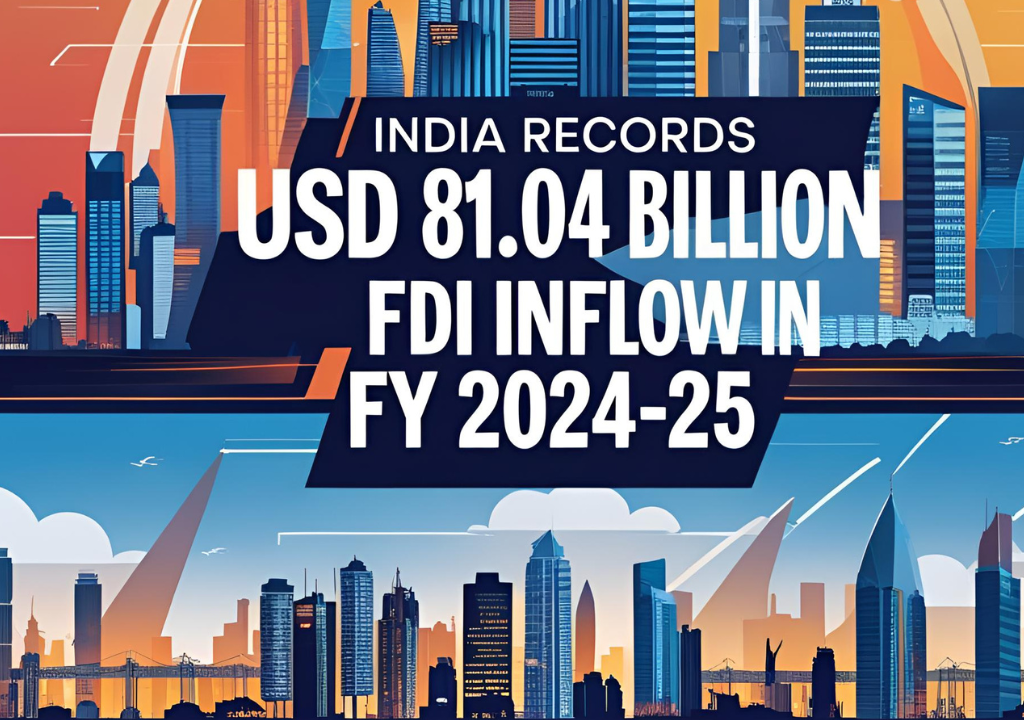India’s foreign direct investment (FDI) story reached a new high in FY 2024–25, with India FDI Inflow 2024–25 touching USD 81.04 billion, a 14% jump over the previous year’s USD 71.28 billion. This surge underscores the success of an investor-friendly policy framework that allows 100% FDI through the automatic route in most sectors. The provisional data, released on 27 May 2025 by PIB Delhi, highlight how the services sector led the charge, while manufacturing and trading also posted robust gains. As global and domestic investors deepen their bets on India’s growth, the India FDI Inflow 2024–25 milestone reaffirms the country’s appeal as a top investment destination.
What Was the Background for India FDI Inflow 2024–25?
Over the past decade, India FDI Inflow 2024–25 has been shaped by a series of policy reforms and global shifts:
- Historical Growth: FDI climbed from USD 36.05 billion in FY 2013–14 to USD 81.04 billion in FY 2024–25, a more than 125% increase over 11 years.
- Policy Liberalization: Since 2014, caps were raised or routes liberalized across defence, insurance, pension, civil aviation, and single-brand retail, creating a transparent, predictable environment.
- Global Supply-Chain Realignment: Geopolitical disruptions and companies seeking alternatives to China have turned India into a manufacturing and services hub.
- Digital Infrastructure Push: Initiatives such as Digital India and production-linked incentives (PLI) for electronics and pharmaceuticals boosted investor confidence in high-growth segments.
These factors laid the groundwork for the record India FDI Inflow 2024–25, positioning India as the world’s fifth-largest FDI recipient.
What Happened Recently in India FDI Inflow 2024–25?
The FY 2024–25 data reveal several key trends:
- Overall Inflow: USD 81.04 billion (provisional), up 14% year-on-year.
- Sectoral Leaders:
- Services: 19% share, USD 9.35 billion (40.8% growth from USD 6.64 billion).
- Computer Software & Hardware: 16% share.
- Trading: 8% share.
- Manufacturing Surge: Grew 18% to USD 19.04 billion, reflecting rising PLI and local production.
- Regional Concentration:
- Maharashtra: 39% of total equity inflows.
- Karnataka: 13%.
- Delhi: 12%.
- Source Country Mix:
- Singapore: 30% share.
- Mauritius: 17%.
- United States: 11%.
- Broader Impact: Over 11 years, India attracted USD 748.78 billion (2014–25), 70% of the total USD 1,072.36 billion since FY 2000–01.
These figures illustrate how India FDI Inflow 2024–25 benefited from both existing investors deepening stakes and new players entering the market.
Links Suggested: Rising North East Investors Summit 2025 Highlights New India Growth
Why Did India FDI Inflow 2024–25 Increase?
Several factors drove the uptick in India FDI Inflow 2024–25:
1. Pro-Investor Policy Reforms
- Automatic Route Expansions: Between 2019 and 2024, 100% FDI under the automatic route was permitted in coal mining, contract manufacturing, and insurance intermediaries.
- Budget 2025 Boost: Proposal to raise the FDI cap from 74% to 100% for insurers investing premiums locally, further liberalizing a crucial sector.
2. Manufacturing Competitiveness
- PLI Schemes: Generous incentives in electronics, pharmaceuticals, and solar modules attracted global manufacturers seeking scale.
- Skilled Workforce & Infrastructure: Ongoing improvements in ports, highways, and power supply reduced operational bottlenecks, making manufacturing an engine for India FDI Inflow 2024–25.
3. Services Sector Dynamism
- Digital Services Boom: The rise of cloud computing, fintech, and IT-enabled services drove 40.8% growth in services FDI.
- Global Captive Centers: Multinationals expanded shared-services hubs in Bengaluru, Hyderabad, and Gurugram, leveraging cost arbitrage and talent pools.
4. Regional and Global Confidence
- State-Level Investment Promotion: States like Maharashtra and Karnataka offered attractive land-bank schemes and single-window clearances, consolidating their lead in FDI.
- Diversified Source Countries: An increase from 89 to 112 source countries shows broad-based interest, reducing over-dependence on any single market.
These enablers combined to make India FDI Inflow 2024–25 one of the strongest performances in recent history.
Links Suggested: PM Modi Chairs NDA Chief Ministers’ Conclave to Boost Double-Engine
What’s Next for India FDI Inflow 2024–25?
To build on this momentum, policymakers and industry must focus on:
- Deepening Ease of Doing Business: Further streamlining compliance, reducing dispute-resolution timelines, and digitizing approvals.
- Enhancing Infrastructure: Finalizing key expressways, port modernizations, and dedicated freight corridors to cut logistics costs.
- Green FDI Push: Incentivizing foreign investment in renewables, battery storage, and electric-vehicle manufacturing to meet net-zero targets.
- SME Integration: Linking small and medium enterprises to global value chains through cluster development and export facilitation.
- Skill Upskilling: Expanding the Skill India programme to align workforce skills with the needs of high-growth FDI sectors.
These steps will ensure that India FDI Inflow 2024–25 is not an outlier but part of a sustained upward trajectory.
Looking Ahead: India FDI Inflow 2024–25 and Beyond
As the global economy evolves, India’s FDI narrative will hinge on:
- Digital Economy Leadership: Scaling AI, data-analytics, and cybersecurity investments to become a regional innovation hub.
- Supply-Chain Resilience: Reducing import dependence by localizing critical inputs, enhancing self-reliance under the Atmanirbhar Bharat vision.
- Regional Integration: Leveraging trade agreements with ASEAN, the EU, and the UK to attract export-oriented FDI.
- Sustainable Growth: Ensuring that FDI inflows align with environmental, social, and governance (ESG) criteria to secure long-term capital.
- Investment Diversification: Targeting under-penetrated sectors such as agritech, biotech, and space services to broaden the FDI base.
With these imperatives, India FDI Inflow 2024–25 can act as the springboard for future peaks, embedding India firmly within global investment circuits.
Conclusion
The India FDI Inflow 2024–25 milestone of USD 81.04 billion reflects the culmination of a decade-long policy push, infrastructure upgrades, and concerted investor outreach. Services led the way, manufacturing held strong, and Maharashtra, Karnataka, and Delhi emerged as prime beneficiaries. As India charts its path toward a USD 5-trillion economy, sustaining and diversifying FDI will be critical. By sharpening ease-of-doing-business, scaling green investments, and integrating SMEs, India can ensure that India FDI Inflow 2024–25 is the foundation—not the pinnacle—of its global investment story.

